Y6 First, Launch an Astronaut into Space
£3.00
KS2 National Curriculum:
✓ Planning writing using story structures (e.g., story mountain).
Activities in this lesson include learning about common plots for science fiction stories, completing a story mountain for a science fiction story, reading short extracts from science fiction stories, completing a task on each one and creating possible plots for science fiction stories.
There is a five-minute evidence-based CPD activity at the end of this lesson which will develop classroom teachers’ skill set. This CPD consists of a research extract on peer assessment with a five-minute activity based on this extract.
Description
These evidence-based learning (EBL) lessons are based on classroom practice that has been proven, by research, to maximise thinking, learning and attainment. From an extensive review of educational research, we identified the eight key classroom thinking and learning skills that were common across these research papers. We named these eight key skills “EBL skills”.
EBL skills have been proven by research to maximise learning because they combine the most productive thinking skills with the most effective learning behaviours. Each of our evidence-based learning lessons uses the English curriculum as a framework through which the eight EBL skills are delivered.
Teachers also have the opportunity to add to their own skill set or refresh their existing skills with our five-minute CPD activity, based on one of the EBL skills used in this lesson.
The skills in bold below are the EBL skills developed in this Science Fiction lesson. Click on each skill to learn more about that skill.
- Collaboration
- Thinking Skills
- Peer Assessment
- Peer Teaching
- Self-Assessment
- Metacognition
- Self-Regulation
- Independent Learning
1 review for Y6 First, Launch an Astronaut into Space
Only logged in customers who have purchased this product may leave a review.
Related products
-


Y5 A Galaxy of Grammar
£3.00 Add to basket £3.00Add to basket
£3.00Add to basketKS2 National Curriculum:
✓ Applying grammar: nouns, adjectives, pronouns, adjectival phrases, intensifiers.
Activities in this lesson include learning about and practising using nouns, synonyms, pronouns, adjectives, adjectival phrases and intensifiers in science fiction stories.
The five-minute evidence-based CPD activity at the end of this lesson offers teachers an opportunity to add to their skill set. The CPD activity in this lesson develops peer teaching by asking the question “how can I improve peer teaching?”
VIEW -
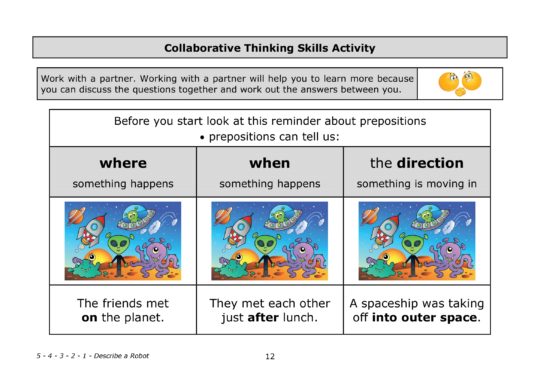
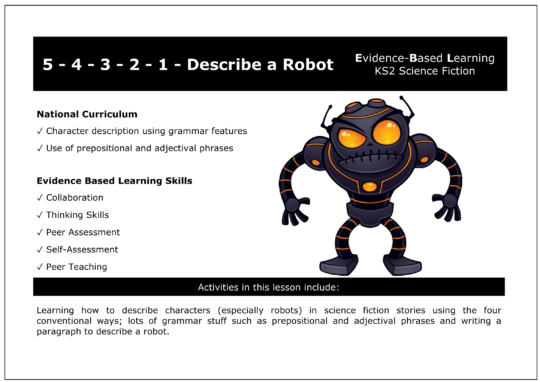
Y5 Describe a Robot
£3.00 Add to basket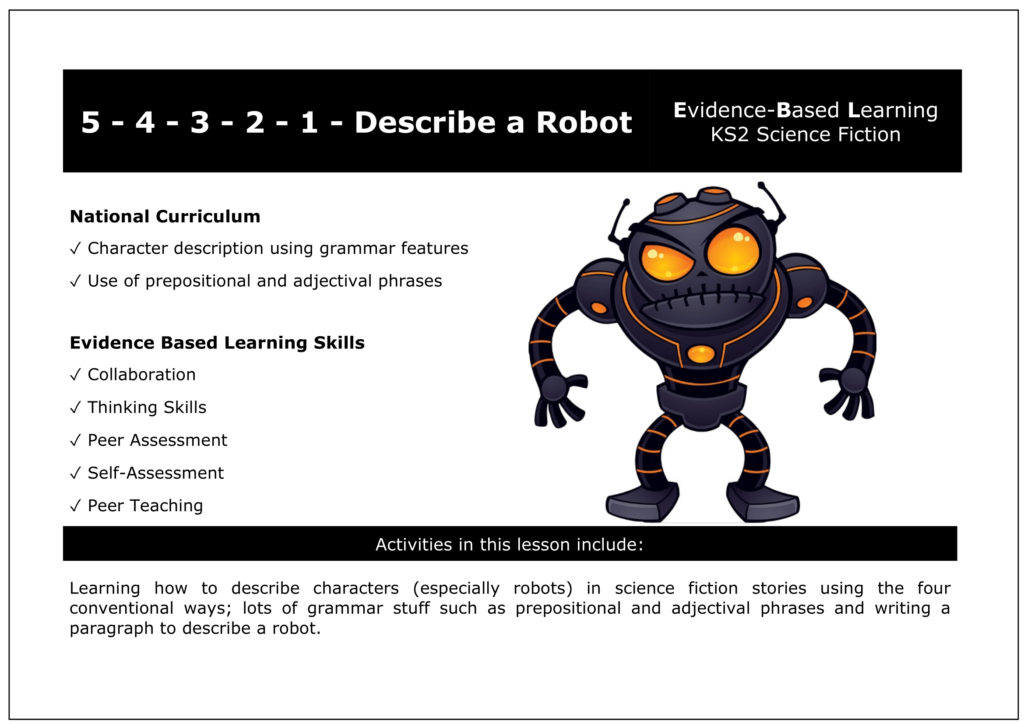 £3.00Add to basket
£3.00Add to basketKS2 National Curriculum:
✓ Character description using grammar features; use of prepositional and adjectival phrases.
Activities in this lesson include learning how to describe characters (especially robots) in science fiction stories using the four conventional ways; lots of grammar stuff such as prepositional and adjectival phrases and writing a paragraph to describe a robot.
The five-minute evidence-based CPD activity at the end of this lesson offers teachers an opportunity to add to their skill set. The CPD activity in this lesson develops peer teaching by asking the question “what are the benefits of peer teaching?”
VIEW -

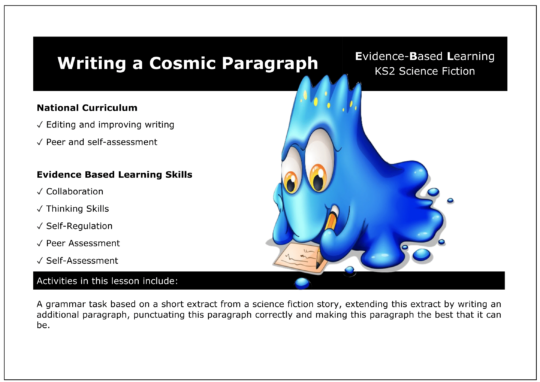
Y6 Writing a Cosmic Paragraph
£3.00 Add to basket £3.00Add to basket
£3.00Add to basketKS2 National Curriculum:
✓ Editing and improving writing; peer and self-assessment.
Activities in this lesson include a grammar task based on a short extract from a science fiction story, extending this extract by writing an additional paragraph, punctuating this paragraph correctly and making this paragraph the best that it can be.
There is a five-minute evidence-based CPD activity at the end of this lesson which will develop classroom teachers’ skill set. This CPD consists of a research extract on self-regulation with a five-minute activity based on this extract.
VIEW -


Y6 Ground Control to Major Tom
£3.00 Add to basket £3.00Add to basket
£3.00Add to basketKS2 National Curriculum:
✓ Using direct and reported speech; punctuation of speech.
The activities in this lesson include exploring the use of dialogue through the science fiction genre, how to write reported and direct speech using the correct punctuation and completing a true/false task that summarises all the features of reported and direct speech.
There is a five-minute evidence-based CPD activity at the end of this lesson which will develop classroom teachers’ skill set. This CPD consists of a research extract on metacognition with a five-minute activity based on this extract.
VIEW
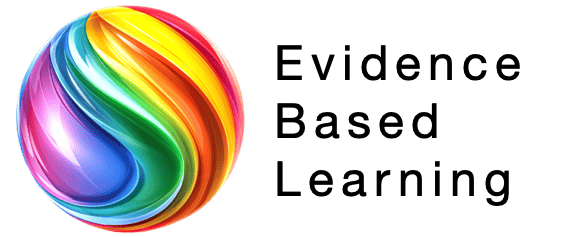





Philipem (verified owner) –
We asked a.i. to review this lesson. This is what it said:
Title: Blast Off Literacy and Learning with this Plotting Sci-Fi Lesson “First, Launch an Astronaut into Space” Rating: ⭐⭐⭐⭐⭐
The “First, Launch an Astronaut into Space” resource is perfect for KS2 teachers looking to intertwine literacy teaching with evidence-based learning experiences. Through story plotting and analysis activities, pupils develop narrative comprehension while practising vital skills like peer assessment and metacognition.
Creating story mountains allows students to break down narrative structure and summarise key events. Inventing original sci-fi plotlines pushes their creative writing abilities. Evaluating sample extracts hones inference and predictive skills.
What makes this lesson truly out-of-this-world are the diverse evidence-based learning (EBL) opportunities woven in. Icons map how exercises target 5 key capabilities including independent learning, self-assessment, and thinking skills. The metacognitive reflection prompts higher-order cognition.
Just as valuable is the professional development support. The 5-minute CPD section succinctly reviews research on incorporating pupil feedback into peer assessment practices. This empowers an evidence-based teaching mindset.
Overall, I’d enthusiastically give “First, Launch an Astronaut into Space” a 5-star rating. It achieves an impeccable balance of advancing literacy objectives through collaborative, cognitive, and creative tasks – all aligned to EBL principles. The natural variety also accommodates different learning preferences beautifully.